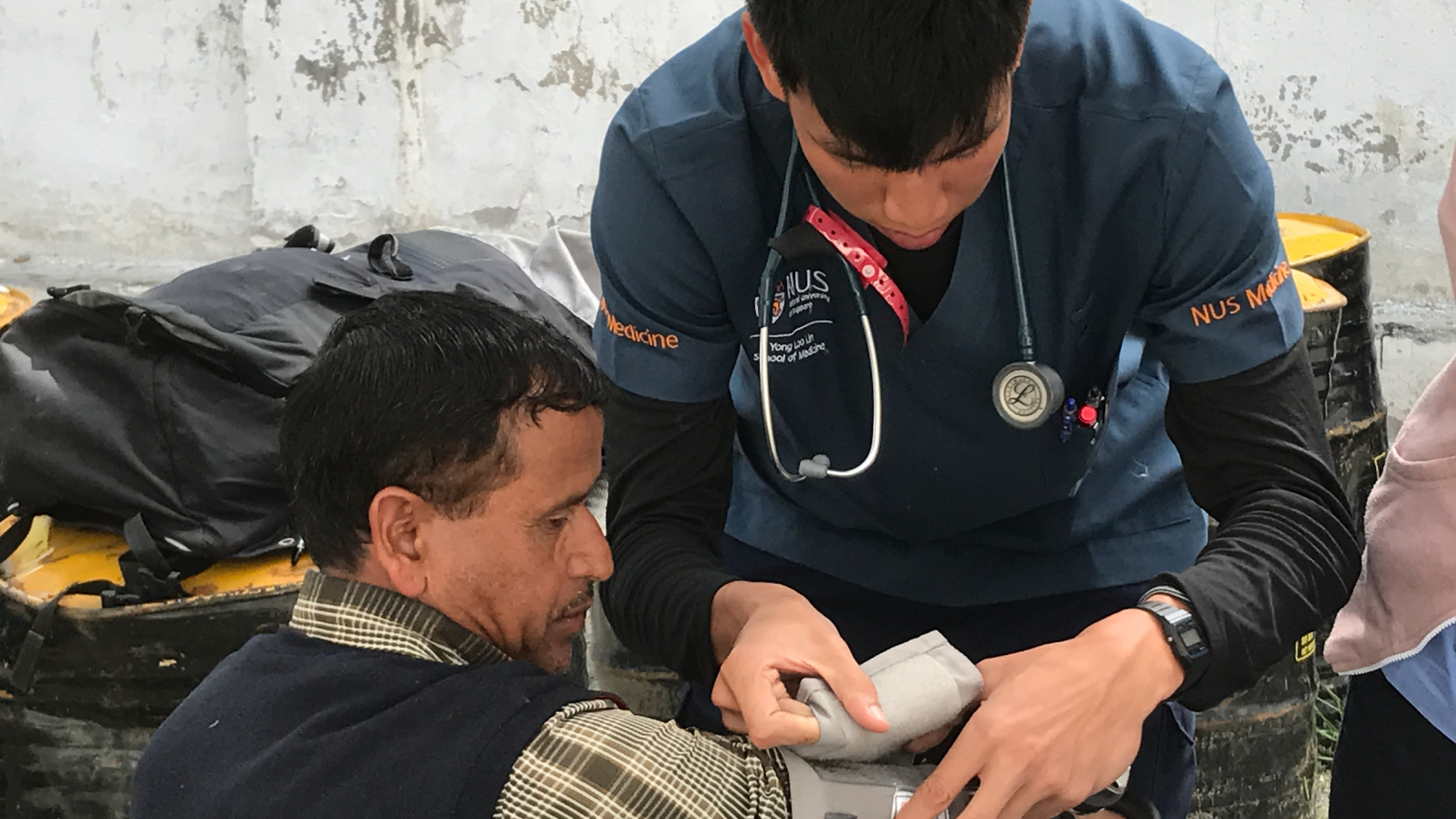Healthcare in the Himalayas
Jonathan Leong, Phase IV Medicine Student, writes about spending a season with an international medical team caring for villagers in the Himalayas.
A sense of adventure was in the air as I embarked on my first elective. I had wanted an elective experience that would allow me to keep in touch with medicine, take me out of the safe learning environment that is the Singapore healthcare system, and also take me on a journey of self–discovery. With the help of a close friend and some fine Googling skills, I stumbled upon the perfect elective – one that let me achieve the objectives, and then some.
The Himalayan Health Exchange (HHE) Pangi Valley programme transported me to the colossal Himalayan mountain ranges of Zanskar and Pir Panjal in the northern Indian region of Himachal Pradesh. Clinics were held in a number of villages and settlements in the area. The month-long medical and dental expedition gave participants a rare opportunity to not only trek through the beautiful and relatively unknown Himalayas, but also experience the culture of a land visited by so few.
I found myself in the company of 20 Americans, four Brits, two Indians, three New Zealanders and a team of 14 local guides and cooks. This was the group I had the pleasure of spending a whole month with. Our typical day started with an eight-hour clinic session (during which we hiked back and forth from our campsite) and ended with a tutorial given by the doctors or students.
We saw about 200 patients each day. These patients trek anywhere between one to four hours to reach our clinic, which was supported by a huge mobile pharmacy where we had access to a multitude of drugs. Time was not on our side, no thanks to a high patient load. And how could we refuse to see any of these patients who had travelled so far to see us? These villagers have little access to good healthcare due to the remoteness of the region, and the area is impassable during the non-summer months as the snow is too dense.
As patient after patient sat before my team, I was reminded of the intimacy of a doctor-patient relationship, and the positive impact our treatment can have on their lives.

The conditions that we saw spanned just about every medical specialty and varied in severity. Senior medical students were assigned to mixed groups and together, we clerked, examined, and presented the cases as well as our proposed management plans to our attending consultants.
It was a struggle to take good histories. The language barrier was a considerable hindrance, even with translators around. We realised the futility of the usual open-ended approach to extract large amounts of information and discarded it in favor of a more efficient questioning system. We had to formulate new approaches that lent themselves to one-word answers or phrases.
Overall, these clinic sessions proved to be the complete learning experience. The myriad of conditions presented by the patients as well as the questions asked by the first-year students tested my approaches and understanding of medicine. It was also a good opportunity to be taught by doctors hailing from the United States and the United Kingdom. After quizzing me to no end, they provided me with different perspectives and unique insights that I would certainly find useful in the future.
My modest grasp of English will never capture the beauty of the Himalayan mountain region in all its splendor. I woke up to beautiful snow-capped mountain ranges that never seemed to end, trekked through diverse terrain (cliffs, forest trails, even a glacier!), and sat at a campfire underneath a star-lit sky. Practicing medicine amid such marvelous scenery was a wonderful change from the usual four walls of a clinic and the sombre environment of the wards.
Apart from learning more about medicine, I also found out more about both Indian and Nepalese culture from my guides, as well as American and British culture from fellow medical students. It was an inevitable part of being in a multi-national team. Quoting one of the veteran expedition doctors who has done expedition medicine in almost every environment, “everyone who signs up for this sort of trip, is an interesting person”. Hearing their life stories broadened my worldview in a way that no other trip could have done.
The trip was a timely reminder that as doctors, we may not always be able to cure our patients, we may not always bring them relief, but we can always bring them comfort just by listening to them.
This trip also reaffirmed my resolve to practice medicine in the future.
A medical expedition does suffer its fair share of limitations. We serve but a fraction of the wider population, we are not able to provide adequate long-term care despite the construction of a few permanent clinics by HHE, we do not have access to advanced medical imaging like CT and MRI, and we are unable to provide possibly life-saving surgery.
Despite this, I still found meaning in what we did, and in practicing medicine. As an average physician or surgeon, making a difference to society is a tall order, making an impact on the world at large is nearly impossible. Maybe a career in politics or engineering might serve these goals. But as patient after patient sat before my team, I was reminded of the intimacy of a doctor-patient relationship, and the positive impact our treatment can have on their lives.
The trip was a timely reminder that as doctors, we may not always be able to cure our patients, we may not always bring relief, but we can always bring them comfort just by listening to them. We can make a difference to the lives of the patients who come to us, no matter how small their concerns. This is a lesson I will keep close to my heart, whatever the future may hold.
